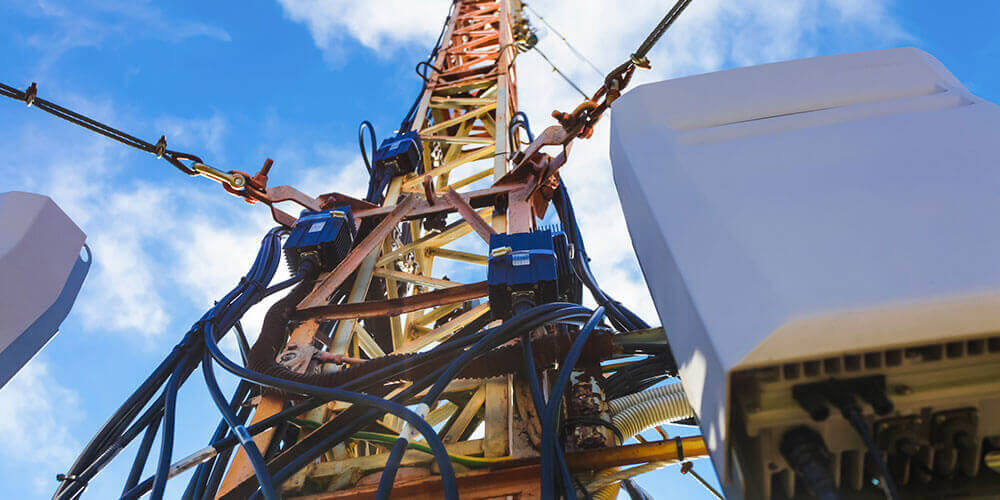Around 2009, the IT industry released a swift, efficient version of mobile connectivity. With speeds as much as 500 times faster than the previous technology, this lighting fast network technology allowed for better video streaming, faster mobile browsing, and smoother video chats.
4G was an important step forward, but the technology is past its prime. The time has come for 5G.
With greater demands for information, more users across the globe, and an increase in “the internet of things,” the need for even faster technology is upon us.
5G is coming, (in many areas, it’s arrived) but the network needs to be expanded and enhanced. To best understand 5G, it helps to compare it to the current 4G technology and towers with 5G.
Here are the differences between a 5G cell tower and a 4G cell tower
5G = 5th Generation of Wireless Network Technology
“5G” is simply the fifth generation of wireless network technology. 1G was released in the late 1970s, and the technology has steadily progressed to the fourth generation (4G), which we are using today. Soon, 5G will take over, but there are still challenges to both devices and the 5G infrastructure that needs to be overcome.
5G is built on “millimeter waves,” which is a new section of the high-frequency spectrum. The spectrum range of 5G covers roughly 5 gigahertz to nearly 96 gigahertz. This is a higher frequency than 4G, creating significantly faster information transfers. However, as we’ll discuss further (See “Infrastructure Challenges” below), high frequency means a lower range. Also, these high-frequency waves are more easily blocked by physical objects, including buildings, trees, houses, and even rain.
Why is 5G Needed?
More items are connected to the internet than ever before, and the amount of connected products is going to continue to multiply. Wireless connections power more than just computers, phones, and tablets. Smart products, appliances, and machinery are driving innovation in previously unthinkable bounds because of the increased efficiency, functionality, and real-time failure analysis made possible by the wireless network.
To deliver information to and from these devices, a new form of connectivity is needed. 4G has certainly served its purpose, moving us from slower internet browsing and emails to smooth video streaming, web conferencing, and online gaming. But we’ve essentially reached peak capacity, and 5G is now essential to keep up with consumption and demand.
4G vs 5G: The Technical and Performance Differences
Information technology tends to progress steadily, continuously improving with faster speeds, greater access, and smaller hardware. With that in mind, it can be easy to assume that 5G is just another step forward. But when you look at the technical and performance differences, 5G is a large project to advance by not a step but a huge leap.
Speed
Users are generally most concerned with download speeds. 4G usually delivers about 10 megabytes per second (MBps) and has the potential for as much as 150 MBps. Users of 5G, however, can expect as much as 50 MBps or higher on a regular basis, and under ideal conditions, the system has the potential for an astonishing 10,000 MBps! With these types of speeds, the word “buffering” will likely be forgotten.
Latency
Latency is also improved with 5G. Latency is the time it takes for a browser and server to communicate with each other, so while you want high data speeds, you want low latency. 4G often delivers about 50 milliseconds (ms) latency, a big improvement from the long latency times of 2G and 3G. But with 5G, it will be possible to have a latency of 1 ms.
Coverage
Of course, all of these high-speed advantages are useless if there is no coverage. In this case, 4G holds a temporary advantage, remaining far more available throughout the country. 4G is found throughout most of the nation, with only a few rural pockets still uncovered by 4G. Most people can access 4G. 5G, however, is currently available in only a few select cities. As of now, to use 5G you need to be located in one of the few areas with 5G towers.
4G vs 5G: A Stats Review
| 4G | 5G | |
| Top Speed | 150 MBps | 10,000 MBps |
| Typical Speed | ≈ 10 MBps | < 50 MBps |
| Latency | 50 ms | 1 ms (possibly) |
| Coverage | Most areas of the U.S | Select cities (currently) |
5G: The Infrastructure Challenge
5G is on the rise, but its availability is currently limited. Of course, the newness of the technology means that enough towers simply have not yet been built to support a coast-to-coast wireless network. But there is also the fact that physical objects block 5G signals easier than 4G, and, even when unobstructed, 5G signals do not carry as far.
This means that more towers are needed to support a comprehensive network. While a few 4G towers might support a moderately-sized city, with 5G, dozens will likely be needed, as towers are required throughout the service area to maximize coverage.
The challenge here means that for mobile users connecting to the 5G network, they would need to have a clear line “of sight” to a 5G node to maintain reasonable connectivity. As such, many more 5G towers are required to reduce dead zones.
One remaining hurdle is the usage and popularization of 5G-capable phones and devices. A user cannot simply pick up a 4G-ready device and jump onto 5G; the device must be made to connect and compatible with the 5G network. This creates one moderate obstacle, which will be steadily overcome with greater user adoption. Market trends report that more people will soon purchase 5G devices, creating a massive demand for 5G cell towers.
The demand for 5G infrastructure is on the rise, and as users increase, cities and facilities need to be proactive in their installation and implementation of the 5G network, so the expansion of faster, better access benefits the population.
5G has been a technology that’s been on the horizon for years however, it is not yet available for most consumers. The next-generation wireless revolution is expected to change your life. High-density settings, such as stadiums and airports is where 5G will make the largest impact. Roll-out began in 2019, setting the stage for widespread 5G adoption this year.
ANS Tower Services provides tower installation and maintenance services for all major wireless carriers, broadband service providers, tower owners, and equipment manufacturers. With extensive experience in telecommunications infrastructure and equipment deployment, ANS delivers superior tower and antenna installation, and provides quality maintenance and inspection services to ensure optimum system performance.





